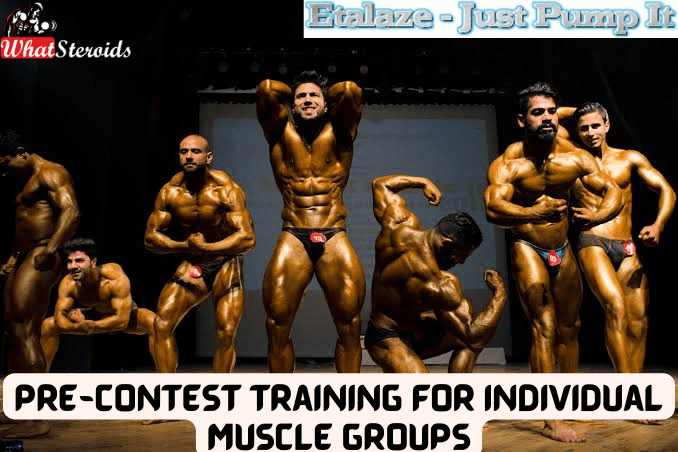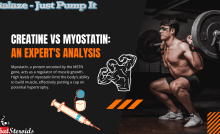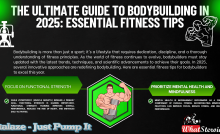Pre-Contest Training For Individual Muscle Groups


Bodybuilding is a highly competitive sport that requires a lot of dedication to achieve the desired physical form. It's not just about looking good; it's about sculpting every muscle group to perfection. Pre-contest training of individual muscle groups is a crucial component of this process.
This guide provides an in-depth analysis of the strategies, techniques, and exercises used by bodybuilders to fine-tune and shape their muscles to prepare for the competition. It covers everything from adjusting training volume and intensity to understanding muscle hypertrophy and conditioning. This article is a helpful roadmap that sheds light on the methodologies elite bodybuilders embrace in the last stages of their journey towards competitive excellence.
Techniques You Can Employ to Target Specific Muscle Groups
Must Read: Post-Cycle Therapy (PCT): Is It Necessary?
Bodybuilders employ various strategies to sculpt their physique for competitions. Here is an overall overview of some techniques and exercises you can use:
Here's a list of major muscle groups that bodybuilders typically focus on.
Chest Muscles
The chest, or pectoral muscles, consist of two primary parts:
Pectoralis major: This is the larger muscle and has two heads - the clavicular head (upper chest) and the sternal head (mid to lower chest). It helps in various movements involving the shoulder joint, like pushing motions.
Pectoralis minor: Situated beneath the pectoralis major, this smaller muscle aids in stabilizing the shoulder blade and assists in movements of the scapula.
Exercises Targeting Chest Muscle Groups
Targeting the chest muscles involves exercises like bench presses, push-ups, chest flys, and various incline or decline movements, which help develop both the upper and lower portions of the chest.
Bench Press: This exercise is a cornerstone for chest development. It can be done with a barbell or dumbbells, targeting the pectoralis major and triceps. Variations include incline, decline, or flat bench presses.
Push-Ups: A bodyweight exercise that engages the entire chest area. Variations like wide-grip, close-grip, or elevated feet can target different parts of the chest.
Dumbbell Flys: Performed lying on a bench, this exercise primarily targets the pectoralis major by simulating a hugging motion.
Chest Dips: Using parallel bars or a dip station, this exercise focuses on the lower chest and triceps.
Cable Crossovers: Performed with cable machines, this exercise isolates the chest muscles by crossing the arms in front of the body.
Related Article: Which Anabolic Steroids Are Less Likely To Cause Acne
Building Well-Defined Back Muscles
Training your back involves targeting various muscle groups:
Latissimus Dorsi (Lats)
These muscles create the V-shape in your back. Exercises like pull-ups, lat pulldowns, rows, and pullovers target the lats.
Trapezius (Traps)
They run from your neck to your mid-back. Shrugs, upright rows, and various types of rows (especially with a focus on the upper portion of the movement) work the traps.
Rhomboids
Located between your shoulder blades, they help with posture and shoulder stability. Rows, reverse flyes, and scapular retractions target the rhomboids.
Erector Spinae
These muscles run along your spine. Deadlifts, hyperextensions, and good mornings are great for developing the erector spinae.
Training strategies for building a strong and well-defined back include:
Exercise Variation: Incorporate a variety of exercises to target different angles and muscle groups within the back.
Progressive Overload: Gradually increase the weight or reps over time to continually challenge your muscles.
Mind-Muscle Connection: Focus on feeling the targeted muscles working during each exercise to maximize their engagement.
Proper Form: Maintain correct posture and form to prevent injury and effectively target the intended muscles.
Frequency: Train your back muscles 1-2 times per week with sufficient rest between sessions.
Nutrition and Recovery: Ensure a balanced diet and adequate rest to support muscle growth and recovery.
Remember, individual responses to training can vary, so it's essential to find what works best for your body and adjust accordingly. Consulting a fitness professional can also provide personalized guidance and support.
Shoulder Muscles
Sometimes you just want to focus on shoulder development. In this case, the key muscles to throw your weight behind are the deltoids (anterior, lateral, and posterior).
Exercises targeting these muscles could include:
Shoulder Press: Works all three deltoid heads.
Lateral Raises: Focuses on the lateral deltoid.
Front Raises: Emphasizes the anterior deltoid.
Rear Deltoid Flyes or Reverse Flyes: Targets the posterior deltoid.
Upright Rows: Engages the lateral deltoid along with other muscles.
It's essential to ensure proper form and gradual progression to prevent injury and maximize muscle growth.
Leg Mucle Groups
Here's a breakdown of major leg muscle groups and exercises to target them:
Quadriceps (front of thighs)
- Squats
- Lunges
- Leg extensions
- Leg presses
Hamstrings (back of thighs)
- Deadlifts (conventional or Romanian)
- Leg curls (lying, seated, or standing)
- Good mornings
Glutes (buttocks)
- Squats (especially deep squats)
- Deadlifts
- Hip thrusts
- Glute bridges
- Lunges
Calves
- Calf raises (standing or seated)
- Jump rope exercises
- Box jumps
- Calf press on leg press machine
Make sure to vary your workouts and incorporate a mix of these exercises to effectively target all the major leg muscle groups for overall leg strength and development.
Training Arms Muscle Groups
Here's a breakdown of the main muscle groups in the arms and exercises to target each:
Biceps
Exercises: Barbell curls, dumbbell curls, hammer curls, preacher curls.
Focus: Flexion of the elbow joint.
Triceps
Exercises: Tricep dips, tricep pushdowns, skull crushers, overhead tricep extensions.
Focus: Extension of the elbow joint.
Forearms
Exercises: Wrist curls, reverse wrist curls, farmer's walks, hammer curls.
Focus: Grip strength, wrist flexion, and extension.
A balanced arm workout typically involves a variety of exercises that target these muscle groups. It's essential to maintain proper form and gradually increase weight or resistance to continue challenging these muscles for growth.
Targeting Abdominal Muscle Groups
Professional bodybuilders focus on various abdominal muscle groups to achieve a well-rounded core. They often target these muscles through exercises like:
Rectus Abdominis: Crunches, sit-ups, leg raises.
Obliques: Russian twists, side plank variations, oblique crunches.
Transverse Abdominis: Planks, bird-dogs, mountain climbers.
Combining these exercises in a routine helps in strengthening and defining the entire abdominal region, crucial for bodybuilders aiming for a balanced physique.
Take Away
In bodybuilding competitions, symmetry and proportion are crucial. Training all muscle groups equally helps achieve a balanced physique, ensuring no muscle group appears underdeveloped compared to others. This balanced look contributes to a better overall aesthetic and judges often favor contestants with symmetrical, proportionate physiques.
Further Reading: 10 Biggest Female Bodybuilders Who Ever Walked the Earth
Recent Posts
Creatine vs Myostatin: An Expert’s Analysis
Myostatin, a protein encoded by the MSTN gene, acts as a regulator of muscle growth.…
Raloxifene (Evista) 101: A Non-Surgical Solution for Gyno
Raloxifene, a selective estrogen receptor modulator (SERM), is one of the most valuable yet less…
Mastering Bodybuilding in 2025: Top Fitness Tips for Success
Bodybuilding is more than just a sport; it's a lifestyle that requires dedication, discipline, and…
Why Post-Cycle Therapy (PCT) Fails After a Nandrolone Cycle
Nandrolone, or Deca Durabolin, is an injectable anabolic steroid often used by bodybuilders during the…
Counteracting Anabolic Resistance with Adaptogens in Aging Men
As people age, maintaining muscle mass and strength becomes increasingly challenging due to a natural…
Tips on How to Store Peptides and HGH
When peptides are mixed with bacteriostatic water (BAC water), their longevity is highly influenced by…



